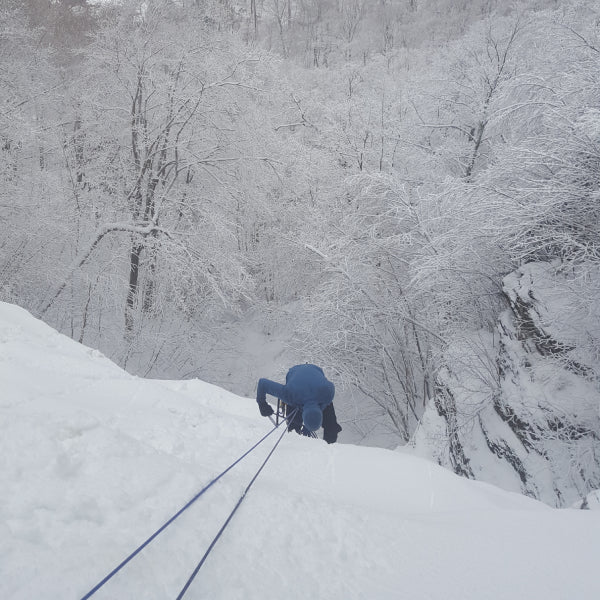Don't Get Cold Feet: Ice Climbing Foot Care Tips

Climbing ice is one of those activities that just conveys a feeling of bone chilling cold to outsiders. Even some of the hardiest rock climbers shake their heads at the thought of ice climbing. But for many people who give it a try, they find it is some of the most fun you can have in the winter!
But, unsurprisingly, the biggest thing that can ruin your day while ice climbing is being ill prepared for the cold, especially when it comes to your extremities. Nothing ruins your day quite like frozen fingers and toes! For this post, I’ll be diving into how to protect your feet, considering socks, boots, and more.
What Socks Should I Wear Ice Climbing?
The answer to this question is “it depends.” It depends on the fit of your boots, objectives for the day, and the temps outside. I commonly wear either a midweight boot height sock or a lightweight over-the-calf sock, depending on whether my day will involve more hiking or more standing around.

Either way, you should definitely choose Merino Wool socks. This naturally thermoregulating material is helpful with activities like ice climbing that involve both intense cardio (approaches up steep, snow-filled gullies) and static belays where you have little choice but to wait patiently while your partner climbs. This combo can lead you to overheat while working hard, which just chills you that much faster while belaying.
Boot Fit
Another factor to consider is the insulation of your boots: older plastic double boots are similar to ski boots and offer a good amount of insulation for your feet and may give you the option to go lighter with your socks. Many modern boots have high end models made for higher elevation (6000M versions) that may be a great option for you if you tend to run cold.
Boot fit is really important with ice climbing technique. If your boots are too small, not only will you not be able to wear warmer socks, but your toes will feel it with every kick into the ice. You want your boots to have room for your toes but to still fit tight enough in the heel and forefoot to keep your foot in place. If your boots are already on the snug side, you may need to opt for a thinner sock (or invest in better-fitting boots).
The Day's Objectives

Taking objectives into consideration is another factor that should be known before you leave the house. If you are climbing in Cody, Wyoming, with huge approaches, a midweight boot height Hiker with cushion is a great bet.
Heavy packs, lots of distance off trail, and sometimes some serious wallowing through snow should make you conscious of all decisions for your feet!
Watch the Forecast
The colder it is, the more you’ll want to consider our heavyweight mountaineering socks. When temps get below 10 degrees, be ready for brittle ice and harder conditions. I’d recommend dressing warmer and bringing extra layers, including an extra base layer to change out when you get to the base of the climb and an extra pair of socks.

It is also good to consider that extreme cold may factor into easing up the day’s objectives, choosing to stay closer to the car, be aware of frost nip and the risk of hypothermia, head home early, and stay hydrated. Winter storms and new snow can rapidly change conditions, many ice climbs are in known avalanche paths, and storms can rapidly load snow in gullies and complex terrain.
On the other hand, ice climbing on a sunny day with temps in the 40’s can be surprisingly warm and pleasant.
What Do Ice Climbers Wear on Their Feet?
Socks: As mentioned above, socks should be something that supports you, instead of ruining your day! Merino Wool makes a huge difference. Also, always go for a sock height that’s a little higher for additional warmth up the leg: boot height and over the calf make a lot of sense. Hiking, Skiing, and Tactical socks are good options to consider. Just like while hiking, it’s never a bad idea to bring an extra pair of socks in your pack!
Ice Boots: A variety of options out there, whatever you choose needs to be compatible with the crampons you are using and should fit well. It is really common to have your boots loosen up on longer approaches and a good practice to retighten your laces as you get ready at the base of your climb. Look for enough room in the toes to not hurt on the kicks but tight enough in the heel and forefoot to feel stable. As a reminder, you don’t want something too small when you spend most of your day kicking crampon points into ice! When purchasing boots, make sure to check the fit while wearing the socks you plan on using.

Crampons: Again, a lot of options out there. For easier ice, you could use glacier crampons, but for most vertical ice you want a good climbing crampon in either a mono-point or dual-point style.
Gaiters: Not always needed, but they can be life savers if you don’t have boots with zippers. Keeping snow out of your boots is key!
Where Can I Learn to Ice Climb?
Regional ice fests are great places to try the gear and learn from experts! The Smuggs Ice Bash in Smugglers Notch, Michigan Ice Fest in the UP of Michigan, Bozeman Ice Fest and the Wyoming Ice Fest in Cody, Wyoming, all offer instruction and gear demos to try the sport!
About the Author
Kevin is a climbing enthusiast and Darn Tough employee that can often be found roaming around Smugglers Notch between December and March. His favorite ice climbing areas are the South Fork (Cody, WY) and Hyalite Canyon (Bozeman, MT).







